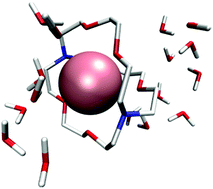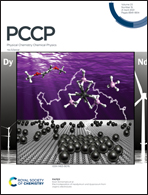Computational predictions of metal–macrocycle stability constants require accurate treatments of local solvent and pH effects†
Abstract
Rational design of molecular chelating agents requires a detailed understanding of physicochemical ligand–metal interactions in solvent phase. Computational quantum chemistry methods should be able to provide this, but computational reports have shown poor accuracy when determining absolute binding constants for many chelating molecules. To understand why, we compare and benchmark static- and dynamics-based computational procedures for a range of monovalent and divalent cations binding to a conventional cryptand molecule: 2.2.2-cryptand ([2.2.2]). The benchmarking comparison shows that dynamics simulations using standard OPLS-AA classical potentials can reasonably predict binding constants for monovalent cations, but these procedures fail for divalent cations. We also consider computationally efficient static procedure using Kohn–Sham density functional theory (DFT) and cluster-continuum modeling that accounts for local microsolvation and pH effects. This approach accurately predicts binding energies for monovalent and divalent cations with an average error of 3.2 kcal mol−1 compared to experiment. This static procedure thus should be useful for future molecular screening efforts, and high absolute errors in the literature may be due to inadequate modeling of local solvent and pH effects.

- This article is part of the themed collection: 2021 PCCP HOT Articles


 Please wait while we load your content...
Please wait while we load your content...
